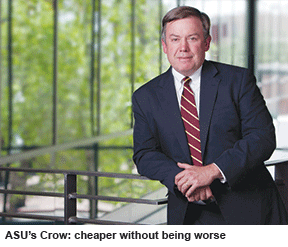 William Bowen, a former president of Princeton, calls it “Harvard envy”. Other American universities try to emulate the Ivy League, which raises costs. They erect splendid buildings, lure star professors with fat salaries and hire armies of administrators. In 1976, there were only half as many college bureaucrats as academic staff; now the ratio is almost 1:1. No wonder average annual fees at private universities have soared to $31,000 (Rs.19.34 lakh) in 2014, an increase of around 200 percent since the early 1970s. Each new graduate in America is now about $40,000 (Rs.25 lakh) in debt. People who sign up for costly arts degrees may end up poorer than if they had never been to college.
William Bowen, a former president of Princeton, calls it “Harvard envy”. Other American universities try to emulate the Ivy League, which raises costs. They erect splendid buildings, lure star professors with fat salaries and hire armies of administrators. In 1976, there were only half as many college bureaucrats as academic staff; now the ratio is almost 1:1. No wonder average annual fees at private universities have soared to $31,000 (Rs.19.34 lakh) in 2014, an increase of around 200 percent since the early 1970s. Each new graduate in America is now about $40,000 (Rs.25 lakh) in debt. People who sign up for costly arts degrees may end up poorer than if they had never been to college.
Digital technology can make college cheaper without making it worse, says Michael Crow, the president of Arizona State University (ASU) in Phoenix and co-author of Designing the New American University. This idea is not new. For a few years now, massive open online courses (MOOCs) have enabled universities to beam lectures to wide audiences at a tiny marginal cost. The problem has always been that taking a Mooc is not the same as attending college in person. MOOCs are cheap, but students cannot bump into each other in the library and swap ideas, chit-chat or exchange body fluids.
ASU seeks to mix online and face-to-face instruction in a way that makes both more effective. For example, one reason why college costs so much is that many students fail to graduate on time. Only three-fifths finish a four-year degree within six years.
This may be because they are ill-prepared when they arrive: shaky numeracy leads many to drop out of courses that require maths.
ASU uses technology to diagnose and address such shortcomings. All students are tested on arrival and given remedial help if needed.
Early results look good: ASU has almost doubled undergraduate enrolments since 2002, to 82,000, kept its degree costs reasonably low ($10,000 a year for in-state applicants) and increased the share of students who graduate after four years from under one-third to half. The goal is to raise that to two-thirds in this academic year.
Providing more of its coursework online also helps a university to serve students based in remote locations. Phil Regier, dean of online studies at ASU, says the number of students who study remotely is growing fast. They pay the same fees as in-state students who live on campus.
This works out well for the university, which can educate more fee-paying students without building bigger lecture halls. Extra sources of income are handy at a time when the state of Arizona is cutting funding for higher education. Crow is quick to spot opportunities: ASU has linked up with Starbucks, a coffee chain, to provide online degrees for company staff.
The notion that online degrees are inferior is also starting to fade. Top-ranked universities such as Pennsylvania State and Columbia now offer them in many subjects. Georgia Tech has had an online-only Masters degree in computer science since 2014, which it considers just as good as its campus version. Minerva, a ‘virtual’ university based in San Francisco, offers online seminars to students who hop from city to city gaining work and cultural experience.
Even Harvard, long a digital resister, has softened a bit. From this year, its Masters course in public health can be done full-time, part-time or in intense bursts. For much of it, students don’t need to be present on campus, so long as they gain the required course-credits. That touches on another idea that could change the way other courses are taught, paid for and accredited: the SPOC (small private online course).
Freeing universities from their geographical constraints might mean undergraduates at, say, Ohio State could collect an extra course-credit or two from Harvard. That could increase choice for students and create new revenue streams for universities with the best digital offerings. Old-fashioned colleges that fail to offer value for money, however, may find their lecture halls start to empty.
(Excerpted and adapted from )